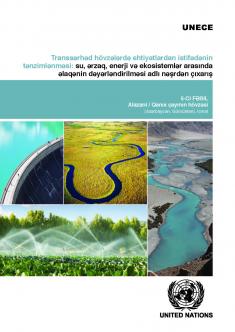Published:

This publication contains the results of the assessment of the water-food-energy-ecosystems nexus ─ essentially of intersectoral links, trade-offs and benefits ─ in the Alazani/Ganykh River Basin, shared by Azerbaijan and Georgia in the Caucasus, that has been carried out in the framework of the UNECE Water Convention’s programme of work for 2013–2015. The methodology employed was developed specifically for assessing the nexus in transboundary basins with multi-disciplinary expertise and was applied with support from various partner organizations.
The assessment aimed to foster transboundary cooperation by identifying intersectoral synergies and determining measures that could alleviate tensions related to the multiple needs of the riparian countries for common resources. The process looked to generate relevant information to support decision-making, and it engaged diverse expertise and key actors in the basins. The participatory assessment process for the Alazani/Ganykh involved an intersectoral workshop for identification of the main intersector issues and possible solutions, detailed by a subsequent analysis, and followed by consultations of the various sectoral authorities concerned.
This nexus assessment summary describes the characteristics of the resources of water, food and land, energy and ecosystem services, and their governance. The assessment shows multiple linkages in the Alazani/Ganykh Basin between the different basin resources, and highlights also that strengthening transboundary cooperation on the integrated management of these resources will bring additional real benefits. Graphics illustrate the interlinkages identified. Climate change and socioeconomic drivers, and their effects on intersectoral dynamics, are also considered.
Finally, a broad range of beneficial response actions are outlined. Such solutions to the nexus span institutions, information, instruments, infrastructure as well as international coordination and cooperation. The solutions underline that policy incentives, economic instruments and other supportive measures need to be well addressed and should consider wider intersectoral impacts. The assessment shows that benefits can also propagate across sectors. For instance, improving access to modern energy sources would limit the use of fuel wood in rural households, which would complement reforestation efforts aimed at reducing erosion, exposure to flood damage and biodiversity loss. More generally, taking into account the potential for multiple uses of infrastructure and the environmental factors, more sustainable development solutions can be found and financial resources allocated more efficiently.
The assessment aimed to foster transboundary cooperation by identifying intersectoral synergies and determining measures that could alleviate tensions related to the multiple needs of the riparian countries for common resources. The process looked to generate relevant information to support decision-making, and it engaged diverse expertise and key actors in the basins. The participatory assessment process for the Alazani/Ganykh involved an intersectoral workshop for identification of the main intersector issues and possible solutions, detailed by a subsequent analysis, and followed by consultations of the various sectoral authorities concerned.
This nexus assessment summary describes the characteristics of the resources of water, food and land, energy and ecosystem services, and their governance. The assessment shows multiple linkages in the Alazani/Ganykh Basin between the different basin resources, and highlights also that strengthening transboundary cooperation on the integrated management of these resources will bring additional real benefits. Graphics illustrate the interlinkages identified. Climate change and socioeconomic drivers, and their effects on intersectoral dynamics, are also considered.
Finally, a broad range of beneficial response actions are outlined. Such solutions to the nexus span institutions, information, instruments, infrastructure as well as international coordination and cooperation. The solutions underline that policy incentives, economic instruments and other supportive measures need to be well addressed and should consider wider intersectoral impacts. The assessment shows that benefits can also propagate across sectors. For instance, improving access to modern energy sources would limit the use of fuel wood in rural households, which would complement reforestation efforts aimed at reducing erosion, exposure to flood damage and biodiversity loss. More generally, taking into account the potential for multiple uses of infrastructure and the environmental factors, more sustainable development solutions can be found and financial resources allocated more efficiently.

